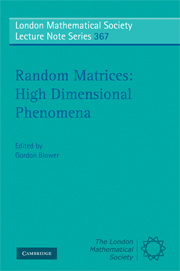Book contents
- Frontmatter
- Contents
- Introduction
- 1 Metric measure spaces
- 2 Lie groups and matrix ensembles
- 3 Entropy and concentration of measure
- 4 Free entropy and equilibrium
- 5 Convergence to equilibrium
- 6 Gradient flows and functional inequalities
- 7 Young tableaux
- 8 Random point fields and random matrices
- 9 Integrable operators and differential equations
- 10 Fluctuations and the Tracy–Widom distribution
- 11 Limit groups and Gaussian measures
- 12 Hermite polynomials
- 13 From the Ornstein–Uhlenbeck process to the Burgers equation
- 14 Noncommutative probability spaces
- References
- Index
2 - Lie groups and matrix ensembles
Published online by Cambridge University Press: 05 March 2012
- Frontmatter
- Contents
- Introduction
- 1 Metric measure spaces
- 2 Lie groups and matrix ensembles
- 3 Entropy and concentration of measure
- 4 Free entropy and equilibrium
- 5 Convergence to equilibrium
- 6 Gradient flows and functional inequalities
- 7 Young tableaux
- 8 Random point fields and random matrices
- 9 Integrable operators and differential equations
- 10 Fluctuations and the Tracy–Widom distribution
- 11 Limit groups and Gaussian measures
- 12 Hermite polynomials
- 13 From the Ornstein–Uhlenbeck process to the Burgers equation
- 14 Noncommutative probability spaces
- References
- Index
Summary
Abstract
The purpose of this chapter is to give a brief introduction to the theory of Lie groups and matrix algebras in a style that is suited to random matrix theory. Ensembles are probability measures on spaces of random matrices that are invariant under the action of certain compact groups, and the basic examples are known as the orthogonal, unitary and symplectic ensembles according to the group action. One of the main objectives is the construction of Dyson's circular ensembles in Sections 2.7–2.9, and the generalized ensembles from the affine action of classical compact Lie groups on suitable matrix spaces in Section 2.5. As our main interest is in random matrix theory, our discussion of the classification is patchy and focuses on the examples that are of greatest significance in RMT. We present some computations on connections and curvature, as these are important in the analysis in Chapter 3. The functional calculus of matrices is also significant, and Section 2.2 gives a brief treatment of this topic. The chapter begins with a list of the main examples and some useful results on eigenvalues and determinants.
The classical groups, their eigenvalues and norms
Throughout this chapter,
R = real numbers;
C = complex numbers;
H = quaternions;
T = unit circle.
By a well-known theorem of Frobenius, R, C and H are the only finitedimensional division algebras over R, and the dimensions are β = 1, 2 and 4 respectively; see [90].
- Type
- Chapter
- Information
- Random Matrices: High Dimensional Phenomena , pp. 42 - 83Publisher: Cambridge University PressPrint publication year: 2009



